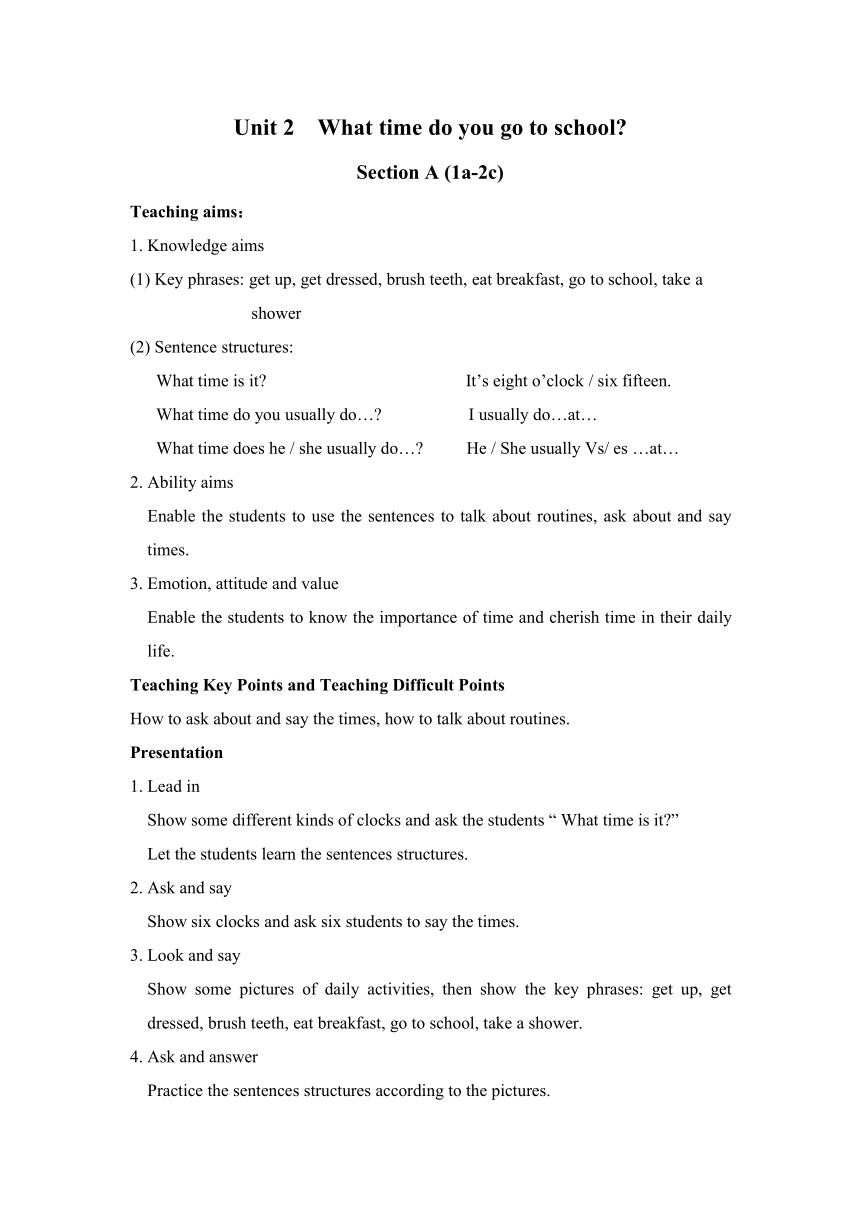Unit 2 What time do you go to school? Section A 1a—2c教案
文档属性
| 名称 | Unit 2 What time do you go to school? Section A 1a—2c教案 |  | |
| 格式 | doc | ||
| 文件大小 | 19.0KB | ||
| 资源类型 | 教案 | ||
| 版本资源 | 人教新目标(Go for it)版 | ||
| 科目 | 英语 | ||
| 更新时间 | 2022-03-15 14:58:54 | ||
图片预览

文档简介
Unit 2 What time do you go to school
Section A (1a-2c)
Teaching aims:
1. Knowledge aims
(1) Key phrases: get up, get dressed, brush teeth, eat breakfast, go to school, take a
shower
(2) Sentence structures:
What time is it It’s eight o’clock / six fifteen.
What time do you usually do… I usually do…at…
What time does he / she usually do… He / She usually Vs/ es …at…
2. Ability aims
Enable the students to use the sentences to talk about routines, ask about and say times.
3. Emotion, attitude and value
Enable the students to know the importance of time and cherish time in their daily life.
Teaching Key Points and Teaching Difficult Points
How to ask about and say the times, how to talk about routines.
Presentation
1. Lead in
Show some different kinds of clocks and ask the students “ What time is it ”
Let the students learn the sentences structures.
2. Ask and say
Show six clocks and ask six students to say the times.
3. Look and say
Show some pictures of daily activities, then show the key phrases: get up, get dressed, brush teeth, eat breakfast, go to school, take a shower.
4. Ask and answer
Practice the sentences structures according to the pictures.
What time do you usually do…
I usually do…at…
What time does he / she usually do…
He / She usually Vs/ es…at…
5. Group work
Talk about their routines with the phrases and sentence.
6. Exercise
Finish 1a.
7. Listening
Listen to 1b.
8. Ask and answer
Ask and answer questions about Rick’s day.
9. Listening
Listen to 2a and 2b.
10. Show time
Write stories about their routines and role play.
11. Exercise
Do some exercise.
12. Summary
Key sentences.
13. Homework
Interview your best friend about her / his daily activities. Then give a report
next class.
Blackboard Design
Unit2 What time do you go to school
What time do you usually do…
I usually do…at…
What time does he/ she usually do…
He / She usually Vs/es…at…
Section A (1a-2c)
Teaching aims:
1. Knowledge aims
(1) Key phrases: get up, get dressed, brush teeth, eat breakfast, go to school, take a
shower
(2) Sentence structures:
What time is it It’s eight o’clock / six fifteen.
What time do you usually do… I usually do…at…
What time does he / she usually do… He / She usually Vs/ es …at…
2. Ability aims
Enable the students to use the sentences to talk about routines, ask about and say times.
3. Emotion, attitude and value
Enable the students to know the importance of time and cherish time in their daily life.
Teaching Key Points and Teaching Difficult Points
How to ask about and say the times, how to talk about routines.
Presentation
1. Lead in
Show some different kinds of clocks and ask the students “ What time is it ”
Let the students learn the sentences structures.
2. Ask and say
Show six clocks and ask six students to say the times.
3. Look and say
Show some pictures of daily activities, then show the key phrases: get up, get dressed, brush teeth, eat breakfast, go to school, take a shower.
4. Ask and answer
Practice the sentences structures according to the pictures.
What time do you usually do…
I usually do…at…
What time does he / she usually do…
He / She usually Vs/ es…at…
5. Group work
Talk about their routines with the phrases and sentence.
6. Exercise
Finish 1a.
7. Listening
Listen to 1b.
8. Ask and answer
Ask and answer questions about Rick’s day.
9. Listening
Listen to 2a and 2b.
10. Show time
Write stories about their routines and role play.
11. Exercise
Do some exercise.
12. Summary
Key sentences.
13. Homework
Interview your best friend about her / his daily activities. Then give a report
next class.
Blackboard Design
Unit2 What time do you go to school
What time do you usually do…
I usually do…at…
What time does he/ she usually do…
He / She usually Vs/es…at…
同课章节目录
- Unit 1 Can you play the guitar?
- Section A
- Section B
- Unit 2 What time do you go to school?
- Section A
- Section B
- Unit 3 How do you get to school?
- Section A
- Section B
- Unit 4 Don't eat in class.
- Section A
- Section B
- Unit 5 Why do you like pandas?
- Section A
- Section B
- Unit 6 I'm watching TV.
- Section A
- Section B
- Review of Units 1-6
- Unit 7 It's raining!
- Section A
- Section B
- Unit 8 Is there a post office near here?
- Section A
- Section B
- Unit 9 What does he look like?
- Section A
- Section B
- Unit 10 I'd like some noodles.
- Section A
- Section B
- Unit 11 How was your school trip?
- Section A
- Section B
- Unit 12 What did you do last weekend?
- Section A
- Section B
